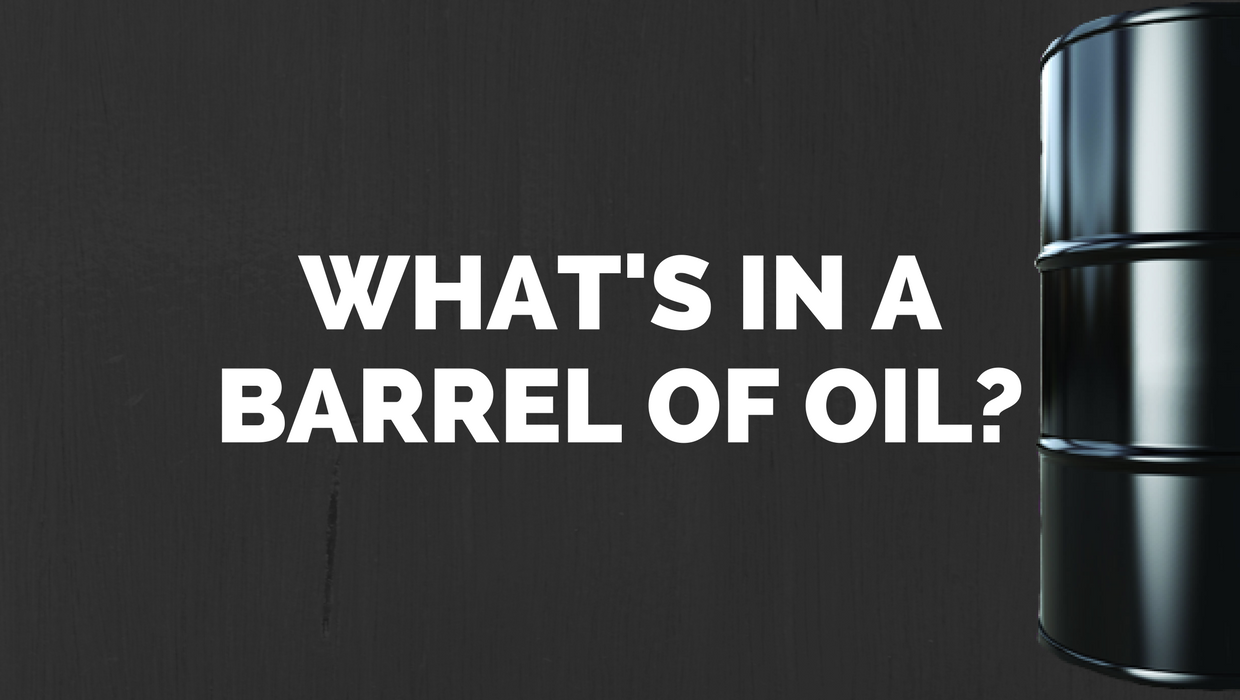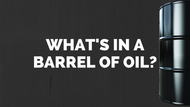What's in a Barrel of Oil? The 42-Gallon Breakdown
By on Mar 01 2022

Have you ever wondered what, exactly, is in a barrel of oil? It's certainly not full of monkeys, that's for sure.
The obvious answer, you might be thinking, is 42-gallons of gooey, black crude. And that's technically correct. However, there is so much more potential in that barrel of oil than fossil fuel alone.
One barrel = 42 US gallons = 159 liters = an abundance of possibilities.
What is crude oil?
First, we'll start with the basics: what is crude oil? Crude oil, also known as petroleum, is a liquid mixture of hydrocarbons, organic compounds, and small amounts of metal found beneath the Earth's surface. Petroleum is created through the heating and compression of very old organic matter (prehistoric plants and animals) over a long period of time. Crude oil is considered a fossil fuel because it is the natural byproduct of decaying plants and animals.
Over this long period of time, the prehistoric algae, zooplankton, and other organic matter settled to the bottom of ancient bodies of water where it all combined with mud. The pressure from layers of sedimentation exposed the organic matter and mud to high temperatures.
Through diagenesis, the chemical composition first turned to a waxy compound called kerogen. Then, with increased heat, the matter turned into a liquid through catagenesis. That liquid is crude oil.
So far, our barrel is full of 50-97% hydrocarbons, between 6-10% organic compounds, and less than 1% metal.
What else is in a barrel of oil?
Untapped possibilities.
Every barrel of unrefined oil also has the potential to be transformed into a number of different products. But before anything can be made, the petroleum must first be refined.
Since crude oil contains various types of hydrocarbons, these need to be separated to form the desired end product (because not all petroleum products are created equally). Fractional distillation occurs when crude oil is heated and the different components of the oil are extracted in stages through their different vaporizing temperatures.
Once refined, crude oil can be transformed into all sorts of useful products, including fuels and other oil-based lubricants.
However, while gasoline production is one of the largest petroleum-based products currently manufactured, gas makes up less than half of a barrel of crude oil.
If gasoline accounts for 46% of our oil barrel, what's happening to the other 54%?
Let's break it down for you:
Twenty-six percent of the remaining crude oil goes into the production of diesel and other fuels.
About nine percent is used to make jet fuel.
Three percent of the crude oil goes into the production of asphalt to pave roads and parking lots.
One percent of this goes into the manufacturing of lubricants: the greases and fluids that help keep our world running smoothly.
The remaining fifteen percent is classified as other. These — "bottom of the barrel" petrochemical products include thousands of different items, ranging from makeup to medicine.
In fact, we highlight these "bottom of the barrel" products in our Petroleum Product of the Week series to showcase just how many products we rely on daily are made using petroleum (at some point in the process).
Did you know that aspirin is a petroleum product? How about food coloring and vape juice? If you dress up your smile with some lipstick, your favorite brand might just be a petroleum product, too.
Every time you reach for something plastic or something made from synthetic rubber, you've got yourself your very own petroleum product. Glasses? Check. Styrofoam? Check. Toothbrush? Check. Even money contains elements of petroleum.
How much oil do we consume?
This is an incredibly difficult question to answer, to be quite honest. One person's oil consumption is entirely dependent on another person's consumption, as well as some random company's consumption. Oil consumption extends well beyond transportation (even if that's the biggest consumer of oil).
For some perspective, though, the US consumed approximately 19.7 million barrels of petroleum per day (b/d) in 2016. That same year, motor gasoline consumption averaged about 9.3 million b/d. Even if you could account for how much fuel you consume, there's difficulty in accounting for how much fuel went into transporting your groceries— or what percentage of a —barrel " went into manufacturing your t-shirt or dish soap.
Sources:
https://oilprice.com/Energy/Crude-Oil/What-Is-Crude-Oil-A-Detailed-Explanation-On-This-Essential-Fossil-Fuel.html
https://www.eia.gov/energyexplained/index.cfm?page=oil_use







